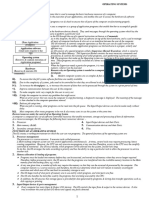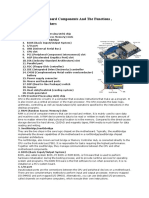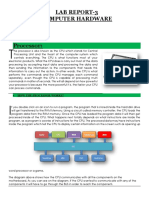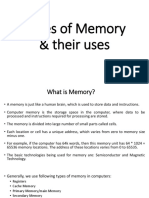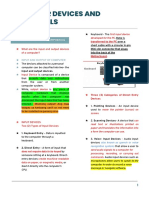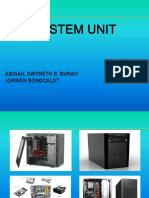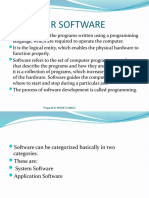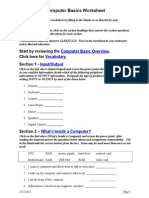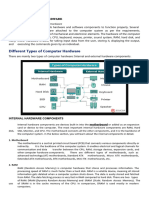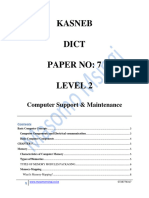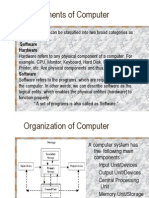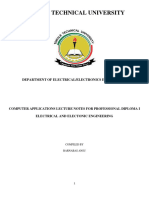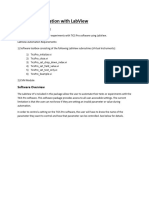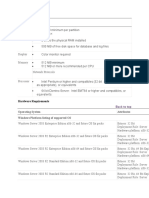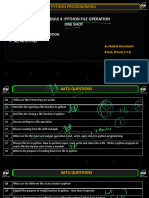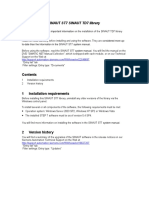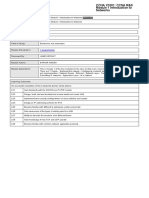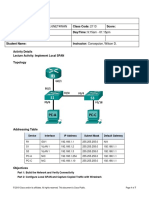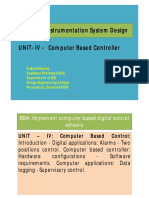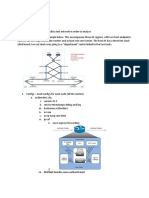SYSTEM UNIT
Is the enclosure for all the other main interior components of a computer. It is also called
the computer case, computer chassis, or computer tower. The term "system unit" is often
used to differentiate between the computer and peripheral devices, such as
the monitor, keyboard, and mouse.
INSIDE THE SYSTEM UNIT
1) CD-ROMs - Stands for "Compact Disc Read-Only Memory." A CD-ROM is a
CD that can be read by a computer with an optical drive. The "ROM" part of
the term means the data on the disc is "read-only," or cannot be altered or
erased. Because of this feature and their large capacity, CD-ROMs are a
great media format for retail software.
2) Hard Drive - is an electromechanical data storage device that uses magnetic storage
to store and retrieve digital information using one or more rigid rapidly rotating disks
(platters) coated with magnetic material.
3) Data Cable – A data cable is a cable that provides communication between devices.
For example, the data cable (i.e., DVI, HDMI, or VGA) that connects your monitor to
your computer and allows your computer to display a picture on the monitor. Other
� popular examples of data cables include the CAT5, IDE/EIDE, SATA,
and USB cables.
4) Mother Board – is one of the most essential parts of a computer system. It holds
together many of the crucial components of a computer, including the central
processing unit (CPU), memory and connectors for input and output devices.
5) Power Cable - is the primary cable that provides power to the
computer, printer, monitor, and components within a computer.
6) Video Card - is an expansion card that allows the computer to send graphical
information to a video display device such as a monitor, TV, or projector.
7) Fan - is a hardware device that keeps the overall computer or a computer
device cool by circulating air to or from the computer or component.
FRONT CASE OF THE SYSTEM UNIT
Floppy disk drive - is a small disk drive used in computers for data
transfer, storage and backup of small amounts of data, as well as installation of
programs and driver updates. A floppy disk drive accesses data recorded on small,
removable diskettes known as floppy disks.
BACK CASE OF THE SYSTEM UNIT
�PARTS OF THE MOTHERBOARD
1. RAM Memory Slot - is what allows computer memory (RAM) to be inserted into the
computer. Depending on the motherboard, there may be two to four memory slots
� (sometimes more on high-end motherboards) and are what determine the type of
RAM used with the computer.
2. Integrated Drive Electronics (IDE) Connector - is a standard interface for
connecting a motherboard to storage devices such as hard drives and CD-
ROM/DVD drives. The original IDE had a 16-bit interface that connected two devices
to a single-ribbon cable.
3. Peripheral Component Interconnect (PCI) slot - is a connecting apparatus for a
32-bit computer bus. These tools are built into the motherboards of computers and
devices in order to allow for the addition of PCI devices like modems, network
hardware or sound and video cards.
4. Accelerated Graphics Port (AGP) - An earlier hardware interface from Intel for
connecting a graphics card (display adapter) to a PC.
5. CMOS (complementary metal-oxide-semiconductor) - is a memory chip that
houses setting configurations and is powered by the onboard battery. The CMOS is
reset and loses all custom settings in case the battery runs out of energy,
Additionally, the system clock resets when the CMOS loses power.
6. North Bridge - is an Intel chipset that communicates with the
computer processor and controls interaction with memory, the Peripheral
Component Interconnect (PCI) bus, Level 2 cache, and all Accelerated Graphics
Port (AGP) activities. Northbridge communicates with the processor using the
frontside bus (FSB).
7. South Bridge - is the chip that controls all of the computers I/O functions, such as
USB, audio, serial, the system BIOS, the ISA bus, the interrupt controller and the
IDE channels. In other words, all of the functions of a processor except memory,
PCI and AGP.
8. Advanced Technology eXtended connector(ATX) - is a specification used to
outline motherboard configuration and dimensions to improve standardization.
9. Central Processing Unit Socket - is the connector on the motherboard that houses
a CPU and forms the electrical interface and contact with
the CPU.Processor sockets use a pin grid array (PGA) where pins on the underside
of the processor connect to holes in the processor socket.
Central Processing Unit - is a piece of hardware that carries out the instructions
of a computer program. It performs the basic arithmetical, logical, and input/output
operations of a computer system.
Expansion Slots - is a socket on the motherboard that is used to insert an expansion
card (or circuit board), which provides additional features to a computer such as video,
sound, advanced graphics, Ethernet or memory.
�Example of Cards:
1. Video Card - is an expansion card that allows the computer to send graphical
information to a video display device such as a monitor, TV, or projector.
2. Sound Card - is an expansion card or IC for producing sound on a computer that
can be heard through speakers or headphones. Although the computer does not
need a sound device to function, they are included on every machine in one form
or another, either in an expansion slot or built into the motherboard (onboard).
3. Network Card - contains the electronic circuitry required to communicate using
a wired connection (e.g., Ethernet) or a wireless connection (e.g., WiFi).
A network interface cardis also known as a network interface controller, network
adapter, or Local Area Network (LAN) adapter.
4. TV tuner Card - is a kind of television tuner that allows television signals to be
received by a computer. Most TV tuners also function as video capture cards,
allowing them to record televisionprograms onto a hard disk much like the digital
video recorder (DVR) does.
5. PC (Printed Circuit Board) card - is a credit card-size memory or I/O device that
fits into a personal computer, usually a notebook or laptop computer. Probably
the most common use of a PC Card is the telecommunications modem for
notebook computers.




